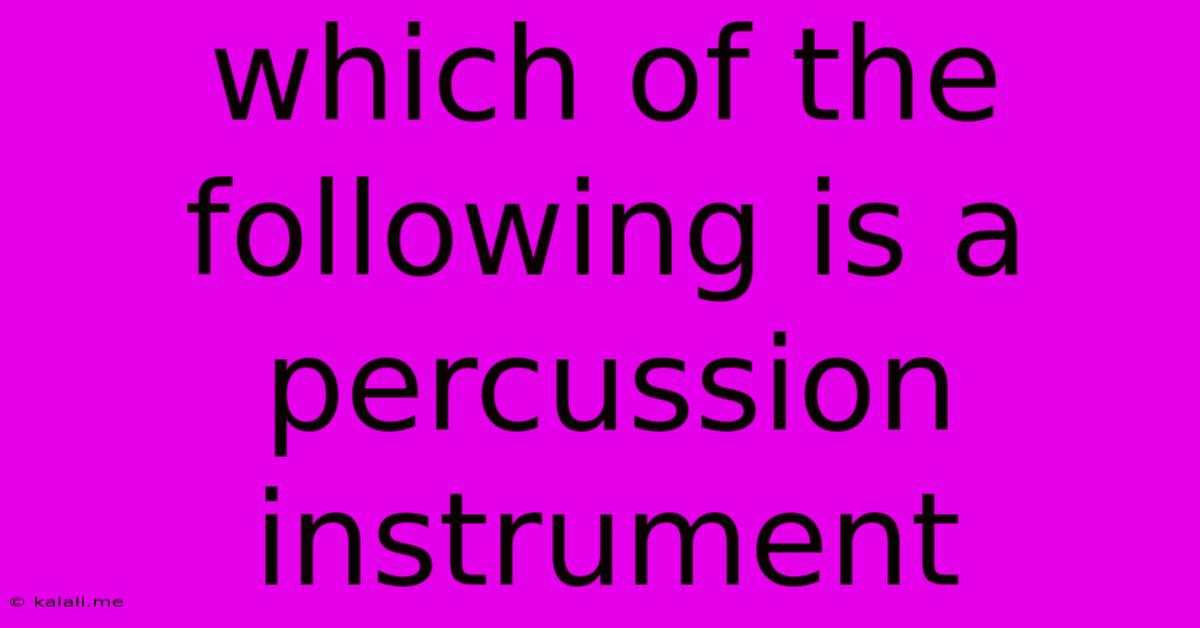Which Of The Following Is A Percussion Instrument
Kalali
Jun 14, 2025 · 3 min read

Table of Contents
Which of the Following is a Percussion Instrument? Understanding Percussion Family
This article will delve into the world of percussion instruments, clarifying what defines them and helping you identify them from other instrument families. We'll explore the characteristics of percussion instruments and provide examples to solidify your understanding. Understanding percussion instruments is crucial for anyone interested in music theory, performance, or simply appreciating the diverse soundscapes music offers.
What is a Percussion Instrument?
Percussion instruments are defined by their sound production method: they are played by being struck, scraped, shaken, or rubbed. Unlike string instruments (like violins or guitars) which produce sound from vibrating strings, or wind instruments (like flutes or trumpets) which use vibrating air columns, percussion instruments generate sound through the vibration of a membrane (like a drumhead), a resonating body (like a xylophone), or directly through striking a solid object. This broad definition encompasses a vast range of instruments from around the globe.
Key Characteristics of Percussion Instruments:
- Sound Production: The primary method of sound production is through striking, shaking, rubbing, or scraping.
- Material Variety: Percussion instruments can be made from a vast array of materials including wood, metal, plastic, skin, and even gourds.
- Pitch Determination: Some percussion instruments produce definite pitches (like xylophones or timpani), while others produce indefinite pitches (like snare drums or cymbals). This distinction is important for musical composition and arrangement.
- Wide Range of Sounds: Percussion instruments offer an incredibly diverse range of sounds, from the deep resonance of a bass drum to the bright, metallic clang of cymbals. This versatility makes them essential in various musical genres.
Examples of Percussion Instruments:
To illustrate, let's consider some common examples, categorized for clarity:
Idiophones (Self-Sounding): These instruments produce sound from their own bodies.
- Xylophone: Wooden bars of varying lengths struck with mallets. Produces definite pitches.
- Cymbals: Thin, metallic discs struck together or individually. Produces indefinite pitches.
- Triangle: A metallic triangle struck with a beater. Produces a ringing, indefinite pitch.
- Castanets: Clapping wooden pieces held in the hand.
- Cowbell: A bell-shaped metal instrument struck with a beater.
Membranophones (Skin-Sounding): These instruments produce sound from stretched membranes.
- Snare Drum: A cylindrical drum with a snare wire across the bottom head.
- Bass Drum: A large drum producing low-pitched sounds.
- Timpani (Kettle Drums): Large, bowl-shaped drums with tunable heads. Produces definite pitches.
- Congas: Tall, narrow drums played with the hands.
- Bongos: Pair of small drums played with the hands.
Chordophones (Technically not Percussion, but often grouped together): While not strictly percussion, instruments like the vibraphone, marimba, and glockenspiel are sometimes included due to their similar playing techniques. These instruments use metal bars or resonant tubes which create notes that are struck by mallets, similar to a xylophone.
Identifying Percussion Instruments:
When trying to identify a percussion instrument, remember to focus on how the sound is produced. If the instrument is struck, scraped, shaken, or rubbed, it's likely a percussion instrument. Consider the material it's made from and whether it produces definite or indefinite pitches.
By understanding these characteristics and examples, you can confidently identify percussion instruments within a wider musical context and appreciate their significant contribution to diverse musical styles and genres worldwide.
Latest Posts
Latest Posts
-
Excel Showing Formula And Not Result
Jun 15, 2025
-
University Of Rhode Island Gpa Requirements
Jun 15, 2025
-
How Hot Is 200 Celsius In Fahrenheit
Jun 15, 2025
-
Least Common Multiple Of 32 And 40
Jun 15, 2025
-
What Are Factor Pairs Of 32
Jun 15, 2025
Related Post
Thank you for visiting our website which covers about Which Of The Following Is A Percussion Instrument . We hope the information provided has been useful to you. Feel free to contact us if you have any questions or need further assistance. See you next time and don't miss to bookmark.